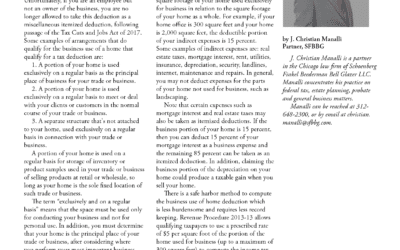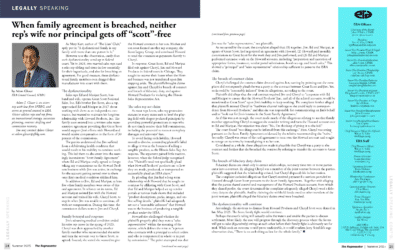While not quite reaching the death and taxes level of certainty, some issues brought to the appellate court still produce highly predictable outcomes.
Challenges to foundations laid by expert witnesses are usually addressed adequately through cross-examination. First-degree murder convictions, especially those appealed on technical grounds, generally get affirmed. Illinois State Police lab technicians follow generally accepted methodologies of firearms identification.
Except when they don’t.
In a surprising decision (as modified on April 22), the 1st District Appellate Court reversed Joe Jones’ first-degree murder conviction after the state’s expert failed to lay an adequate foundation for his testimony that Jones’ pistol fired the fatal round at Ivory Anderson. People v. Jones, 2015 IL App (1st) 121016.
At trial, state police lab forensic scientist Justin Barr recounted how he examines a bullet recovered from a crime scene and a test bullet by using a comparison microscope to determine if there is “sufficient agreement” with a recovered firearm to link the two bullets.
Barr explained that state police lab examiners find sufficient agreement between items “just based on our training and experience” and follow neither a national standard nor an Illinois State Police standard. A second examiner is then asked to provide verification.
Utilizing this approach, Barr testified he linked the bullet recovered from Anderson’s body to Jones’ .38-caliber Grendel pistol. When defense counsel objected to the foundation laid, the state suggested probing into this on cross-examination. The trial court then overruled the objection.
On cross, Barr admitted “there is no set number” of matching characteristics the lab examiners look for and that each examiner can independently decide what is sufficient agreement. To obtain verification of his findings, Barr lined up his microscope at the index mark before involving another technician, indicating he already found an identification.
No set procedure exists for choosing a verifier. Barr could not recall a technician ever disagreeing with him or him with any other examiner. Disagreements did occur, but he was unsure if the lab tracked them.
On redirect, Barr asserted his methods and procedures were commonly accepted in his field to determine if a bullet was fired from a particular firearm. After the jury convicted Jones, he appealed, challenging this expert testimony.
The 1st District reviewed the standards for all expert testimony. As in civil actions, the proffered expert must be qualified, a proper foundation must be laid establishing that the information upon which the opinions are based is reliable, and the testimony must assist in the understanding of the evidence.
The defendant had not challenged Barr’s qualifications, so this element was not at issue on appeal. Similarly, the testimony’s value to assist the jury’s understanding of the weaponry used in Anderson’s murder was not in dispute.
The appeal focused instead on the foundation for Barr’s testimony, specifically the reliability of the information he based his opinion on.
Although Illinois follows the widely used standard for scientific evidence promulgated in Frye v. U.S., 293 F. 1013 (D.C. Cir. 1923), where courts examine the methodology employed by the expert to determine if it is generally accepted, no such analysis proved necessary.
Only where an expert offers an opinion on new or novel scientific methodologies does Frye require a foundation be laid for whatever scientific principle or evidence is used to arrive at the opinion.
Comparing bullets for firearms identification was not new and did not require a Frye analysis.
Instead, the appellate court applied the universal standard for expert testimony, scientific or otherwise. Laying an adequate foundation involves showing that the expert’s facts or data are of a type reasonably relied upon by experts in the field in forming opinions or inferences.
General scientific acceptance can be shown through “scientific publications, prior judicial decisions, practical applications as well as the testimony of scientists as to the attitudes of their fellow scientists.” While firearm comparison and identification has long been regarded as generally accepted and admissible in Illinois, testifying experts must still lay a foundation establishing that the facts they rely upon are of a type reasonably relied upon in their field.
Meeting this foundational requirement “is an admissibility issue, not merely weight,” and expert testimony can be received only once the proponent shows the information upon which he bases his opinions is reliable. This Barr failed to do.
Even though Barr explained that each particular firearm has its own set of individual characteristics setting it apart from others, Barr never described any such individual characteristics of either Jones’ .38-caliber pistol or the purportedly matching bullet.
As the court put it, “Barr gave no reason at all to support his expert opinion that there was sufficient agreement and a match between the bullet recovered by the victim and defendant’s gun.”
Because “there literally was no foundation for Barr’s expert opinion testimony,” he essentially asked the jury to “take my word for it.”
The court wouldn’t have it. “What is at issue is the most basic foundational requirement for the admission of an expert opinion.” By offering no supporting facts, Barr prevented a meaningful crossexamination, shifted the burden of proof to the defense and circumvented the gatekeeping requirement of laying a proper foundation.
Because “Barr’s testimony placed the murder weapon in defendant’s hands,” the error in admitting the opinion was not harmless. The court therefore reversed Jones’ murder conviction and remanded the case for a new trial.
Failing to lay a proper foundation rarely proves quite so consequential, yet the proponent of expert testimony — in civil or criminal cases — must recognize the importance of detailing the basis for the opinion offered, including showing the reliability of the information upon which the expert’s opinion is based. Experts must “give some reason for his or her opinion.”



